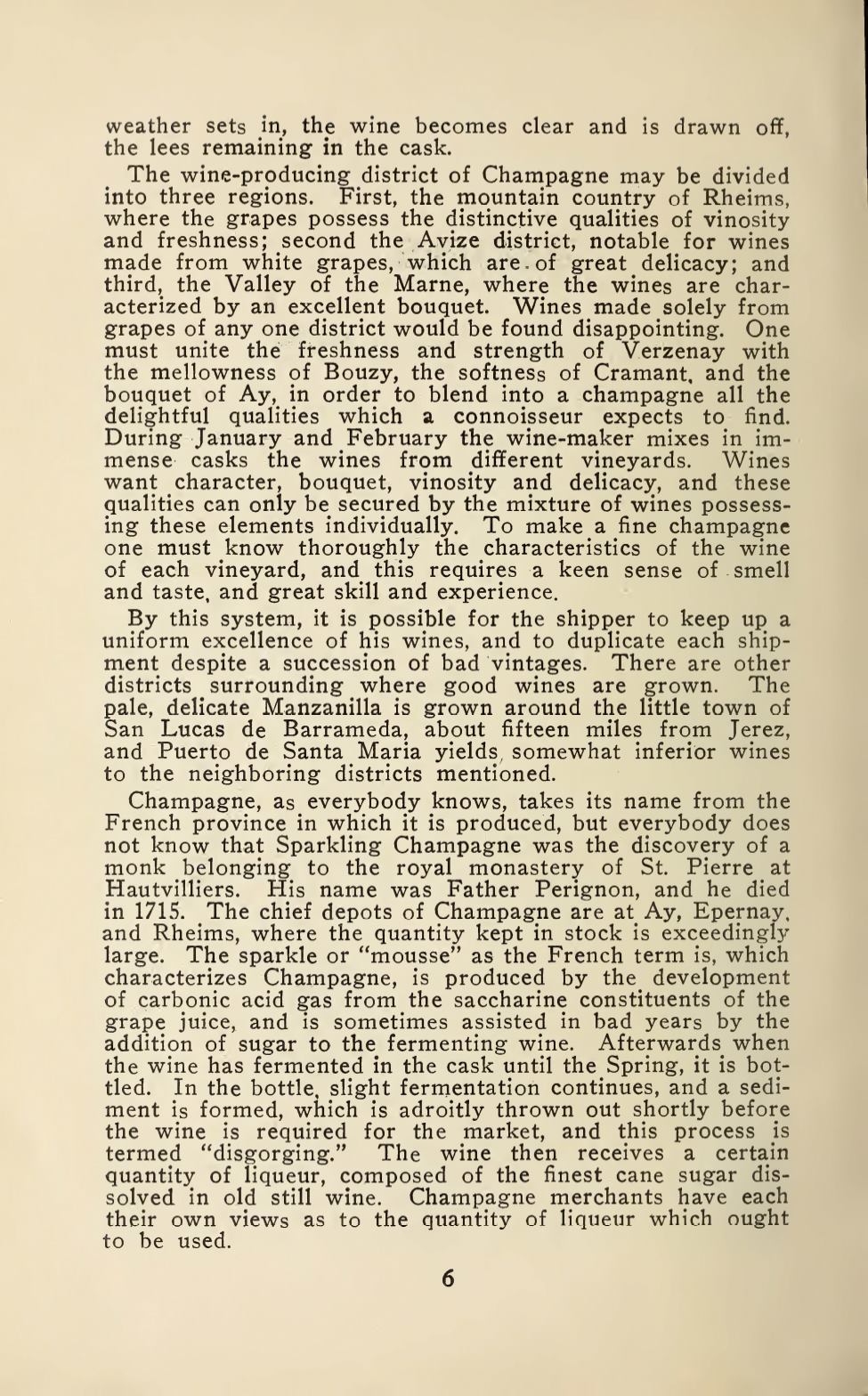

weather
sets
jn,
the
wine
becomes
clear
and
is
drawn
off,
the
lees
remaining
in
the
cask.
The
wine-producing
district
of
Champagne
may
be
divided
into
three
regions.
First,
the
mountain
country
of
Rheims,
where
the
grapes
possess
the
distinctive
qualities
of
vinosity
and
freshness;
second
the
Avize
district,
notable
for
wines
made
from
white
grapes,
which
are.
of
great
delicacy;
and
third,
the
Valley
of
the
Marne,
where
the
wines
are
char-
acterized
by
an
excellent
bouquet.
Wines
made
solely
from
grapes
of
any
one
district
would
be
found
disappointing.
One
must
unite
the
freshness
and
strength
of
Verzenay
with
the
mellowness
of
Bouzy,
the
softness
of
Cramant,
and
the
bouquet
of
Ay,
in
order
to
blend
into
a
champagne
all
the
delightful
qualities
which
a
connoisseur
expects
to
find.
During
January
and
February
the
wine-maker
mixes
in
im-
mense
casks
the
wines
from
different
vineyards.
Wines
want
character,
bouquet,
vinosity
and
delicacy,
and
these
qualities
can
only
be
secured
by
the
mixture
of
wines
possess-
ing
these
elements
individually.
To
make
a
fine
champagne
one
must
know
thoroughly
the
characteristics
of
the
wine
of
each
vineyard,
and
this
requires
a
keen
sense
of
smell
and
taste,
and
great
skill
and
experience.
By
this
system,
it
is
possible
for
the
shipper
to
keep
up
a
uniform
excellence
of
his
wines,
and
to
duplicate
each
ship-
ment
despite
a
succession
of
bad
vintages.
There
are
other
districts
surrounding
where good
wines
are
grown.
The
pale,
delicate
Manzanilla
is
grown
around
the
little
town
of
San
Lucas
de
Barrameda,
about
fifteen
miles
from
Jerez,
and
Puerto
de
Santa
Maria
yields,
somewhat
inferior
wines
to
the
neighboring
districts
mentioned.
Champagne,
as
everybody
knows,
takes
its
name
from
the
French
province
in
which
it
is
produced,
but
everybody
does
not
know
that
Sparkling
Champagne
was
the
discovery
of a
monk
belonging
to
the
royal
monastery
of
St.
Pierre
at
Hautvilliers.
His
name
was
Father
Perignon,
and
he
died
in
1715.
The
chief
depots
of
Champagne
are
at
Ay,
Epernay,
and
Rheims,
where
the
quantity
kept
in
stock
is
exceedingly
large.
The
sparkle
or
"mousse"
as
the
French
term
is,
which
characterizes
Champagne,
is
produced
by
the^
development
of
carbonic
acid
gas
from
the
saccharine
constituents
of
the
grape
juice,
and
is
sometimes
assisted
in
bad
years
by
the
addition
of
sugar
to
the
fermenting
wine.
Afterwards
when
the
wine
has
fermented
in
the
cask
until
the
Spring,
it
is
bot-
tled.
In
the
bottle,
slight
fermentation
continues,
and
a
sedi-
ment
is
formed,
which
is
adroitly
thrown
out
shortly
before
the
wine
is
required
for
the
market,
and
this
process
is
termed
"disgorging."
The
wine
then
receives
a
certain
quantity
of
liqueur,
composed
of
the
finest
cane
sugar
dis-
solved
in
old
still
wine.
Champagne
merchants
have
each
their
own
views
as to
the
quantity
of
liqueur
which
ought
to
be
used.
6


















